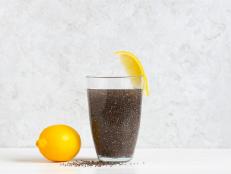Is Honey Healthy?
Find out how to make this natural sweetener part of a healthy diet.

Prostock-Studio
Added sugar has gotten a bad reputation and honey has been caught in the crossfire. Sure, it's a natural sweetener, but is it actually healthy? Honey can certainly be part of a healthy, well-balanced diet when consumed in small amounts. Read on to learn more.
Where Honey Comes From
Honey has been around for thousands of years. In fact, an 8,000 year old cave painting in Valencia, Spain depicts honey being harvested. It’s also been used for food, medicine and much more in cultures around the world.
The true stars in the history of honey are the bees that visit millions of blossoms in their lifetimes, making the pollination of plants possible, collecting nectar to bring back to their hives. The excess honey (about 65 pounds of surplus each year) bees make is removed by beekeepers who then bottle it for humans to enjoy.
Nutritional Breakdown of Honey
One tablespoon of honey provides 64 calories, 17 grams of carbs and a total of 17 grams of sugar. It’s free of fat, protein and sodium. Honey also provides small amounts of vitamins, minerals and phytonutrients (flavonoids and phenolic acids), which act as antioxidants.
Honey’s Health Benefits
1. Honey Can Improve Gut Health
A subgroup of bacteria called bifidobacteria is thought to help maintain optimal gut health. These good bacteria can be increased when you eat the prebiotics. A prebiotic helps stimulate the growth of good bacteria while suppressing the growth of harmful bacteria. One of the most common prebiotics are called oligosaccharides, many of which are found in honey. Research conducted at Michigan State University has shown that adding honey to fermented dairy products (like Greek yogurt) can help with the grown, activity, and viability of bifidobacteria.
2. Honey Provides Antioxidants
Honey contains a wide variety of flavonoids and phenolic acids. These phytochemicals have been shown to act as antioxidants. The antioxidants found in honey depend on the type of plants the bee was pollinating. As a general rule, the darker the honey, the more antioxidants it contains. Researchers at the University of Illinois Champaign/Urbana looked at the antioxidant capacity (called ORAC) of various types of honey. The results showed that buckwheat honey (which is darker in color) had over 5 1/2 times the ORAC compared to acacia honey (a very light colored honey derived from acacia flowers).
3. It's a source of energy
Nutrient-filled foods like oatmeal, bran, or plain yogurt aren’t very flavorful on their own. Adding sugar, just a small amount, can help make these healthy foods more palatable. Honey provides 64 calories per tablespoon compared to 46 calories found in the same amount of table sugar. Although, based on calories alone, you may think that table sugar is the better choice, honey is sweeter than table sugar so you can use a fraction of the amount. Most recipes use half the amount of honey when substituting for sugar.
4. Honey Can Help Relieve Irritation of a Sore Rhroat
The World Health Organization (WHO) recommends honey as a potential treatment for acute cough and cold symptoms (though, never give honey to a child under the age of 1 year old). This study also found that honey can be beneficial in helping alleviate symptoms of the common cold.

Betsie Van der Meer/Getty Images
Is Honey an Added Sugar?
Added sugar, according to the FDA, includes sugars that are “either added during the processing of foods or are packaged as such (e.g., a jar of honey, container of maple syrup, or a bag of table sugar)”. Currently, the FDA’s definition of added sugar doesn’t differentiate between sugars added to the diet verses those added to the product, and many folks are interpreting the added sugars label on honey to mean that sugar is added to the product, which is not the case with honey. Honey is a pure product made by bees and doesn’t have sugars added to it.
“The FDA recognizes that added sugars can be part of a balanced diet,” says Barry. “The [FDA’s] concern is that excess consumption of added sugars may make it difficult for consumers to eat enough foods with enough dietary fiber and essential vitamins and minerals while staying within daily calorie limits.” In addition, the 2015-2020 dietary guidelines recommend no more than 10% of total calories to come from added sugar. This does leave room to use honey in small amounts to enhance the flavor of dishes like oatmeal or plain yogurt.
Raw vs. Filtered Honey
There has been some buzz (pun intended!) that raw honey is healthier than filtered honey (or the jarred honey typically sold at your local supermarket). “While there is no official U.S. federal definition of ‘raw’ honey, it generally means honey that has not been heated or filtered,” says Barry, who feels that this belief started because raw honey may contain small amounts of pollen grains that are often removed during processing or filtering. “Honey is produced by honey bees from the nectar of plants, not pollen. Pollen occurs only incidentally in honey. The amount of pollen in honey is miniscule and not enough to impact the nutrient value of honey,” says Barry. A 2004 study by the Australian government found the percentage of dry weight canola pollen in 32 Australian canola honey samples ranged from 0.15% to 0.433%.
How to Store Honey
Honey should be stored in a sealed container at room temperature (64-75 F) to prolong shelf life and prevent the honey from crystallizing. Storing it at high temperatures can cause the honey to darken and dull in flavor. Note to all kitchen hoarders: Honey usually lasts about two years if properly stored (through heavily processed varieties can last forever!). For more information, check out our story, Does Honey Go Bad?.
Related Links:


































